Flow States– LA TRIENAL 2024
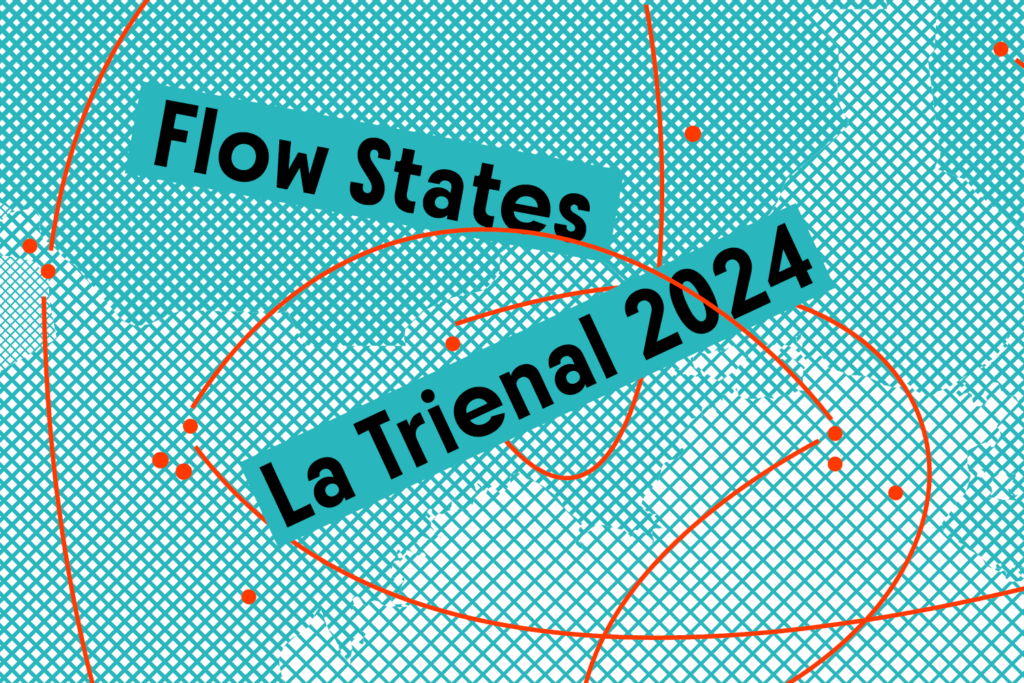
Flow States – LA TRIENAL 2024 is El Museo del Barrio’s second large-scale survey of Latinx contemporary art. Organized by El Museo’s chief curator Rodrigo Moura, curator Susanna V. Temkin, and guest curator María Elena Ortiz, the exhibition features artists working across the United States, Puerto Rico, and—for the first time—extending into new geographies that reflect the complexities of diasporic flows, with artists based in the Americas, the Caribbean, Europe, and Asia.
Emphasizing plurality and a sense of movement, the title, Flow States, is a pun on creative focus and the fluidity of geographic boundaries and cultural exchanges. This phrase connects to diasporic themes—broadly defined as a dispersion, scattering, and flux of populations, languages, and cultures—that inform the exhibition. The selected artists share interests related to transformation, porosities of landscape and the built environment, spiritual connections, collective memories, hybrid belongings, and material exchanges. This edition builds on the framework of the critically acclaimed ESTAMOS BIEN – LA TRIENAL 20/21, the museum’s inaugural survey of Latinx contemporary art—the first of its kind in the United States. Flow States is accompanied by a fully illustrated, bilingual publication.
The exhibition will have a staggered closing: selected galleries will remain open through March 16. Please note that the last day to view the full exhibition is February 9, 2025.
ABOUT THE CURATORS
Rodrigo Moura
Rodrigo Moura is a curator, writer, and editor currently serving as Chief Curator at El Museo del Barrio in New York. At El Museo, Moura has curated Cuerpo: Carlos Martiel (2024), ESTAMOS BIEN – LA TRIENAL 20/21, and Raphael Montañez Ortiz – A Contextual Retrospective (2022). Previously, he was the Adjunct Curator of Brazilian Art at Museu de Arte de São Paulo Assis Chateaubriand (MASP), where he curated or co-curated exhibitions such as Djanira: Picturing Brazil (2019), Melvin Edwards: Lynch Fragments (2018), Images of the Aleijadinho (2018), and Who’s Afraid of Teresinha Soares? (2017). Moura also served as Artistic Director of Instituto Inhotim (Minas Gerais, Brazil) between 2014 and 2015, where he was also curator from 2004 to 2013.
María Elena Ortiz
María Elena Ortiz is a Curator at the Modern Art Museum of Fort Worth, where she curated Surrealism and Us: Caribbean and African Diaspora Art since 1940 (2024) and Jammie Holmes: Make the Revolution Irresistible (2023). Previously, she was a Curator at the Pérez Art Museum Miami (PAMM), where she organized group shows such as Allied with Power: African and African Diaspora Art from the Jorge M. Pérez Collection (2020) and The Other Side of Now: Foresight in Caribbean Art (2020), as well as solo exhibitions with Firelei Báez, Ulla von Brandenburg, william cordova, Teresita Fernández, José Carlos Martinat, Carlos Motta, and Beatriz Santiago Muñoz. At PAMM, Ortiz founded the Caribbean Cultural Institute, a curatorial platform dedicated to Caribbean art, and worked to grow the museum’s collection by securing works by Simone Leigh, Bisa Butler, Bony Ramirez, and others.
Susanna V. Temkin
Susanna V. Temkin is a Curator at El Museo del Barrio in New York and holds a PhD from the Institute of Fine Arts at New York University. At El Museo, she has curated or co-curated exhibitions such as Cuerpo: Carlos Martiel (2024), Something Beautiful: Reframing La Colección (2023–2024), DOMESTICANX (2022), Juan Francisco Elso: Por América (2022), ESTAMOS BIEN – LA TRIENAL 20/21, and Culture and the People: El Museo del Barrio, 1969–2019 (2019), among others. Prior to joining El Museo, Temkin was an Assistant Curator at Americas Society in New York and the Research and Archive Specialist at Cecilia de Torres, Ltd., where she co-authored the digital catalogue raisonné of artist Joaquín Torres-García. Her essays and reviews have been published in exhibition catalogues and magazines, including The Metropolitan Museum of Art’s Alice Neel: People Come First, Rutgers, Art Review, and The Burlington Magazine.
ABOUT THE CATALOGUE
Flow States – LA TRIENAL 2024 is accompanied by a fully illustrated, 360-page catalogue
with curatorial essays and newly commissioned short essays on participating artists by
invited collaborators. Contributors include Chloë Courtney, Raquel Gutiérrez, Jennifer
Inacio, Elena Ketelsen González, Mia Lopez, Dessane Lopez Cassell, Zuna Maza, Serubiri
Moses, Yxta Maya Murray, Marina Reyes Franco, and Julián Sánchez González. Edited by
Rodrigo Moura, María Elena Ortiz, and Susanna V. Temkin. Designed by Elaine Ramos
and Flavia Castanheira, Estúdio Gráfico, São Paulo. English and Spanish. Published by El
Museo del Barrio, New York.
EXHIBITION CREDITS
Flow States – LA TRIENAL 2024 is made possible by the Jacques and Natasha Gelman Foundation. Leadership support is provided by the Rockefeller Brothers Fund. Major support is provided by the National Endowment for the Arts and Tony Bechara. Generous funding is provided by the Mex-Am Cultural Foundation and the Trienal Council: Patrick Collins, Virginia Cowles Schroth, Agnes Gund, María Eugenia Maury, Ramiro Ortiz Mayorga, Kunal Kishore Shah, Monica Vidal and Joseph Sherman. Additional support is provided by Marilyn Pearl Loesberg, Javier Lumbreras, Isabel and Julio Nazario, Robert and Encarnita Quinlan, and Tracey and Phillip Riese. Public support is provided by the New York City Department of Cultural Affairs.

Ocama Aracoel
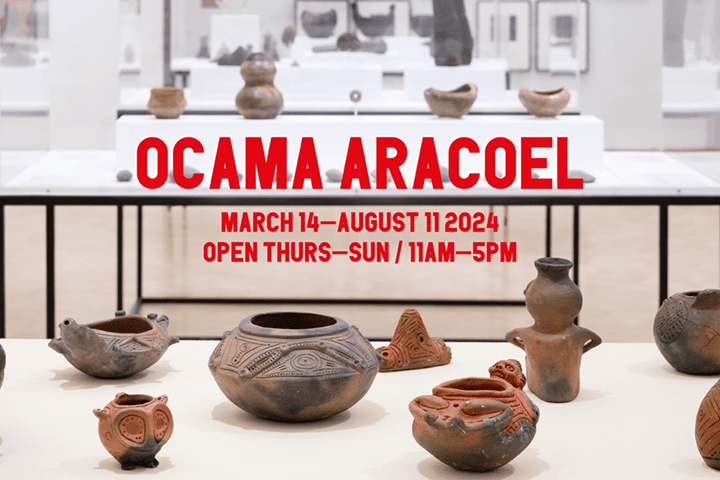
Titled Ocama Aracoel, this gallery remains on view from the long-term exhibition Something Beautiful: Reframing La Colección, which reexamined El Museo del Barrio’s unique and culturally diverse permanent collection. Meaning “a call to the ancestors” in the Taíno language, Ocama Aracoel is the last iteration of the exhibition and foregrounds the importance of Taíno cultural inheritance. As part of this project, El Museo invited a Taíno advisory council to guide the reinstallation of these spiritually resonant forms.
The Taíno peoples have inhabited the Caribbean for many thousands of years. Their forms, symbols, and beliefs continue to provide a living resource for cultural reconnection within the Caribbean diasporic community. This visual language informed El Museo’s early mission and graphic identity. Similarly, these forms have shaped the practices of artists both in Puerto Rico and New York, including members of the influential Taller Boricua and their contemporaries. New commissions by Glendalys Medina and Jorge González Santos further activate these histories. Together, these dialogues reflect the ongoing vitality of Taíno culture and resist the racist notion of its extinction.
The exhibition is organized by Rodrigo Moura, chief curator; Susanna V. Temkin, curator; Lee Sessions, permanent collection associate curator; and Chloë Courtney, Marica and Jan Vilcek curatorial fellow; with Daniel A. Silva, registrar; and Michelle McVicker, former permanent collection associate registrar. Ocama Aracoel is advised by Christina Gonzalez and the Taíno council, formed by José Hatuey Barreiro, Kasike Jorge Baracutay Estevez, and Domingo Turey Hernandez.
Something Beautiful: Reframing La Colección is made possible by the Terra Foundation for American Art and the Jacques and Natasha Gelman Foundation, with additional support provided by Tony Bechara. Public support provided by the NYC Department of Cultural Affairs. Additional permanent collection funding provided by the Mellon Foundation.
Amalia Mesa-Bains: Archaeology of Memory
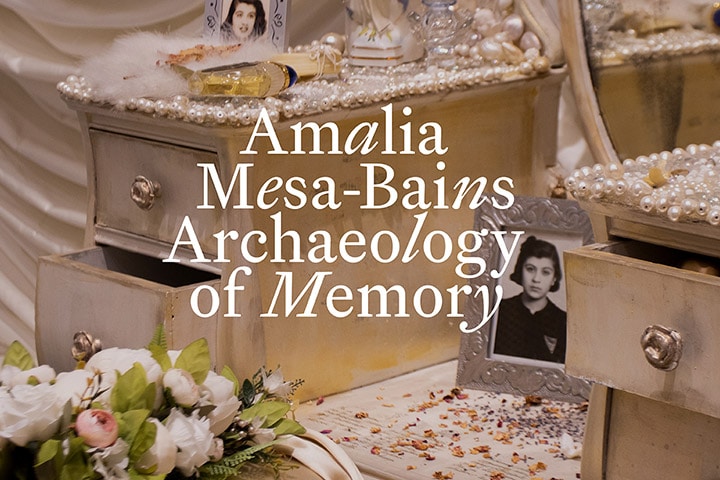
El Museo del Barrio presents Amalia Mesa-Bains: Archaeology of Memory, the first retrospective exhibition by the pioneering artist, curator, and theorist. Born in 1943 to a Mexican immigrant family, Mesa-Bains has been a leading figure in Chicanx art for nearly half a century. Her practice explores intersectional feminist themes, environmentally centered spirituality, and cultural diversity to counter the racist and gendered erasures of colonial repression. The exhibition features over 40 works including the artist’s large-scale “altar-installations”, as well as prints, artist books, and codices. Anchored by the multi-chapter “Venus Envy” series, Archaeology of Memory is a rare opportunity to view three decades of Mesa-Bains’s genre-defying artworks, many of which are on display together for the first time.
El Museo del Barrio is the only East Coast venue to host the traveling retrospective, which is organized by the Berkeley Art Museum and Pacific Film Archive in collaboration with the Latinx Research Center (LRC) at UC Berkeley. The presentation at El Museo expands on Mesa-Bains’s longstanding association with the institution, where her work has been exhibited since the 1990s. Most recently, her art and critical writing served as the direct inspiration for the acclaimed 2022 exhibition DOMESTICANX, an intergenerational Latinx group presentation that expanded on Mesa-Bains’s ground-breaking theory of domesticana.
In the mid-‘70s, Mesa-Bains’s research in Mexican ancestral traditions led to her groundbreaking reimagination of sacred forms—altares (home altars) and ofrendas (offerings to the dead)— through a contemporary lens as installation art. In the following decades, the artist expanded her altar-based practice, converting domestic furniture such as a desk, table, armoire or vanity into places of devotion and memory. Subsequently, Mesa-Bains began to consider spaces at the intersection of the private and public to explore the lives of female figures from historical and religious contexts, including Mexican nun and intellectual Sor Juana Inés de la Cruz and La Virgin de Guadalupe. These sites, which include a library, harem, garden, and laboratory, provide the settings for Mesa-Bains’s archeological inquiry into women’s histories and their colonial erasure.
Mesa-Bains’s groundbreaking developments are showcased in the multi-part Venus Envy series, created between 1993 and 2023 and on view in four galleries of El Museo del Barrio. Archaeology of Memory marks the first time that Venus Envy is being shown in its entirety, having originally been staged in four chapters across different institutional settings, including the 1993 Whitney Biennale; Williams College Museum of Art; the Bernice Steinbaum Gallery; and the Menil Collection. Riffing off Freudian terminology, Mesa Bains’s title is suggestive of women’s empowerment throughout history. Other installations speak to the experience of migration, women’s solidarities, and ancestral knowledge in order to reclaim the histories that have been absented from public memory through the patriarchal institutions of nation, religion, and museum. These large-scale pieces are complemented throughout the exhibition by works on paper that illuminate the artist’s aesthetic of textual and image-based layering and excavation in two-dimensional form. Drawing on familial histories, personal experiences, and artistic legacies, these prints, handmade books, and codices inform Mesa-Bains’s conceptual practice and serve as maps for her artistic trajectory.
ABOUT AMALIA MESA-BAINS
Amalia Mesa-Bains’s work is in the collections of leading art institutions, including the Museum of Fine Arts, Houston, TX ; National Gallery of Art, Washington, D.C.; San Francisco Museum of Modern Art, CA; Smithsonian American Art Museum, Washington D.C.; and Williams College Museum of Art, Williamstown, MA; and has been shown at the Museo de Arte Contemporáneo Carrillo Gil, Mexico City, Mexico; Biblioteca Luis Angel Arango, Bogota, Colombia; Contemporary Exhibition Center of Lyon, France; El Centro de Arte Contemporáneo de Santa Monica, Barcelona, Spain; and Kulturhuset Stadsteatern, Stockholm, Sweden.
Mesa-Bains is a distinguished author, curator, and educator who holds a Ph.D. in clinical psychology from the Wright Institute in Berkeley. She has been the recipient of numerous international awards throughout her career, among them, the prestigious MacArthur “Genius” Grant in 1992. She is the first and thus far the only Chicana visual artist bestowed the honor.
Beginning in the ’60s, Mesa-Bains became a leader in the movement that sought recognition of Chicanx history in the United States, and a tireless voice in advancing that movement through education, advocacy, critical writing, and most significantly, through her own practice that created a visual archive of Chicanx life. In the late ‘70s, as part of her dissertation at the Wright Institute, Mesa-Bains interviewed 10 Chicana artists of her generation about their lived experiences, art-making, and the influence of culture on their identities. In the following decades, she continued her work to increase the visibility of Chicanx and Latinx artists, as an author contributing early scholarship to the field, and as a curator.
Mesa-Bains’s influence on a younger generation of artists specifically and on the broader Latinx community is evident in her curatorial and outreach projects. At her request, the exhibition of her work at the Whitney Museum of American Art in 1993 was augmented by a partnership with a school serving recent Latino immigrants. At San Francisco’s Galeria de la Raza, she created a training program to empower a new generation of Chicanx intellectuals to direct that institution’s programming. Amalia Mesa-Bains: Archaeology of Memory is organized by the Berkeley Art Museum and Pacific Film Archive in collaboration with the Latinx Research Center (LRC) at UC Berkeley.
The show is curated by Maria Esther Fernández, Artistic Director, The Cheech Marin Center for Chicano Art & Culture of the Riverside Art Museum and Laura E. Pérez, Professor of Chicanx, Latinx, and Ethnic Studies and Chair of Latinx Research Center, UC Berkeley. The exhibition is made possible by generous lead support from the Henry Luce Foundation and The Andy Warhol Foundation for the Visual Arts.

El Museo del Barrio’s presentation is organized by Susanna V. Temkin, Curator, with Chloë Courtney, the Marica and Jan Vilcek Curatorial Fellow. The presentation is made possible by the Mex-Am Cultural Foundation, with additional support provided by Tony Bechara, Juan Domingo Beckmann, Estrellita and Daniel Brodsky, Agustín Coppel Luken, Craig Robins, Stanley Stairs, and Maestro Dobel Tequila. Public support is provided by the New York City Department of Cultural Affairs.

Cuerpo: Carlos Martiel
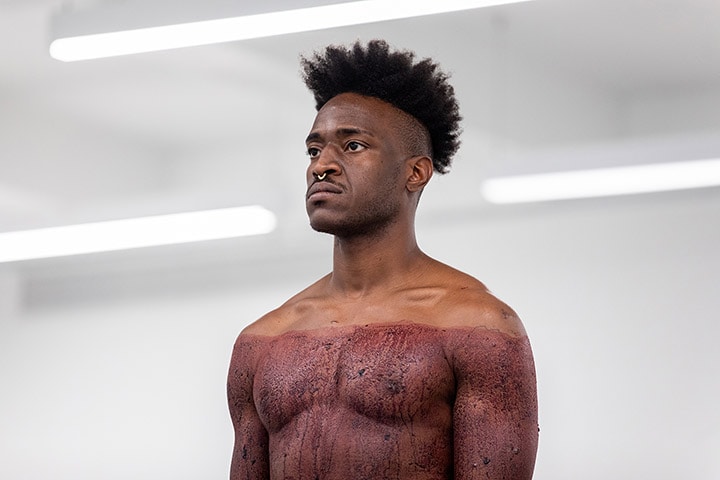
El Museo del Barrio is proud to present the first solo exhibition in a New York City museum of Carlos Martiel, the inaugural recipient of the Maestro Dobel Latinx Art Prize.
This groundbreaking survey, on view from May 2 to September 1, 2024, encapsulates Martiel’s performance-based practice of nearly two decades. Employing his body as a primary medium, Martiel utilizes endurance performances in both public and gallery spaces to delve into the complex legacies of colonialism on race, labor, and migration. The exhibition features a selection of the artist’s most significant projects to date, bringing together different spaces and temporalities through preparatory drawings, photographs, and videos, as well as the remains of past sculptural performances, in dialog with El Museo’s multidisciplinary project space, Room 110.
Carlos Martiel has been a prominent figure in the New York art scene for the past decade. However, his practice transcends strict geographic limits, responding to different political and cultural contexts. His approach pushes the limits of self-expression to explore the impact of systems of oppression on BIPOC and Latinx communities. This survey exhibition marks his return to the institution since his debut in La Trienal, in which Martiel presented the first version of his acclaimed Monuments series. Since then, additional iterations of this ongoing work have been performed in New York, Dakar, and Mexico City, all of which will be included as part of the El Museo del Barrio presentation.
This exhibition is accompanied by a new fully illustrated, bilingual (Spanish/English) publication that will serve as the first comprehensive monograph of the artist, highlighting approximately 40 performances from across Martiel’s career. The publication will include an introduction from El Museo’s curators and a specially commissioned essay by guest author and scholar Genevieve Hyacinthe.
ABOUT CARLOS MARTIEL
Carlos Martiel (born 1989, Havana), lives and works in New York. He graduated in 2009 from the National Academy of Fine Arts San Alejandro in Havana. Between the years 2008-2010, he studied in the Cátedra Arte de Conducta, directed by the artist Tania Bruguera.
Martiel’s works have been included in the 11th Lanzarote Biennial, Spain; Biennial of the Americas, USA; 4th Vancouver Biennale, Canada; 14th Sharjah Biennial, UAE; 14th Cuenca Biennial, Ecuador; 57th Venice Biennale, Italy; Casablanca Biennale, Morocco; Biennial “La Otra”, Colombia; Liverpool Biennial, United Kingdom; Pontevedra Biennial, Spain; Havana Biennial, Cuba. He has had performances at The Leslie-Lohman Museum of Art, New York; Solomon R Guggenheim Museum, New York; El Museo del Barrio, New York; Stedelijk Museum, Amsterdam; La Tertulia Museum, Cali, Colombia; Centro de Arte Contemporáneo, Quito, Ecuador; Walker Art Center, Minneapolis; The Museum of Fine Arts Houston (MFAH); Museo de Arte Contemporáneo del Zulia (MACZUL), Maracaibo, Venezuela; Padiglione d’Arte Contemporanea, Milan; and Nitsch Museum, Naples. He has received several awards, including the Franklin Furnace Fund in New York, 2016; “CIFOS Grants & Commissions Program Award” in Miami, 2014; “Arte Laguna” in Venice, 2013. His work has been exhibited at The São Paulo Museum of Art (MASP), São Paulo; The Museum of Latin American Art (MOLAA), Long Beach; Zisa Zona Arti Contemporanee (ZAC), Palermo; Patricia and Phillip Frost Art Museum, Miami; Benaki Museum, Athens; National Museum of Fine Arts, Havana; and El Museo del Barrio, New York, among others.
His works are in public and private collections such as the Solomon R. Guggenheim Museum, New York; The Pérez Art Museum Miami (PAMM); and Museu de Arte do Rio, Rio de Janeiro.
CREDITS
The Maestro Dobel Latinx Prize was created by Maestro Dobel Tequila in collaboration with El Museo del Barrio to raise awareness and amplify the cultural production of Latinx artists practicing across the United States and Puerto Rico.
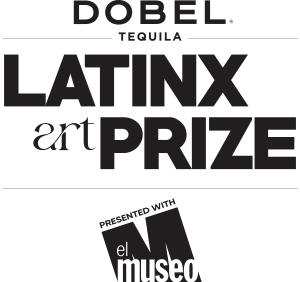
The exhibition is organized by Rodrigo Moura, chief curator, and Susanna V. Temkin, curator.
Something Beautiful:
Reframing La Colección
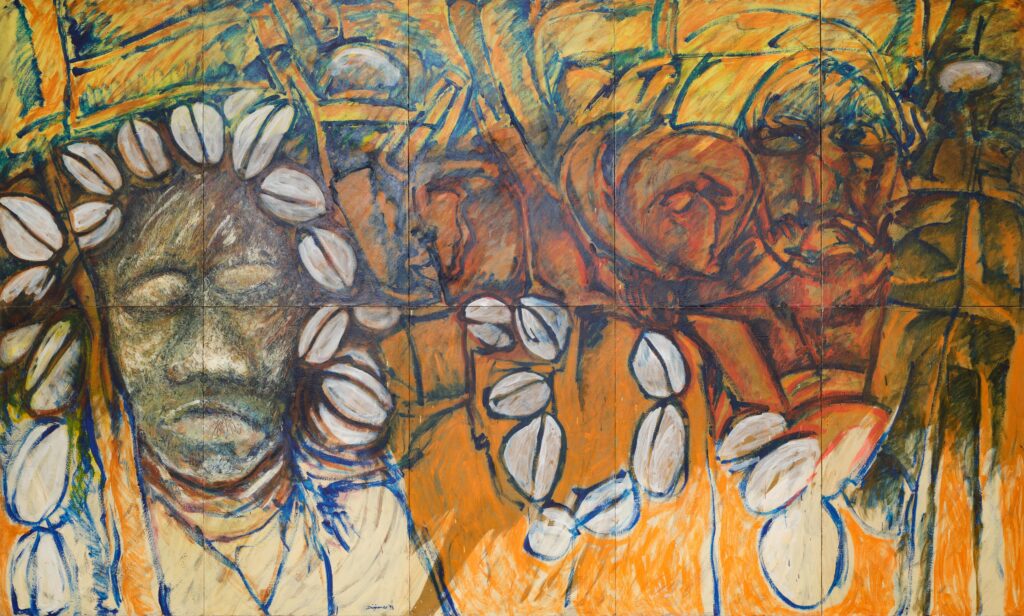
Something Beautiful: Reframing La Colección is El Museo del Barrio’s most ambitious presentation of its unique, complex, and culturally diverse permanent collection in over two decades. Organized by Rodrigo Moura, Chief Curator; Susanna V. Temkin, Curator; and Lee Sessions, Permanent Collection Associate Curator, the exhibition will present approximately 500 artworks, including new acquisitions and artist commissions, through rotating displays over the course of one year. Something Beautiful cuts across traditional chronological, geographic, and media-specific categories, reconsidering the Collection through new interdisciplinary approaches rooted in El Museo del Barrio’s foundational history and legacy. This forward-thinking model focuses on the contribution of Amerindian, African, and European cultures as the basis of visual production in the Americas and the Caribbean.
The first rotation of Something Beautiful: Reframing La Colección is organized in eight sections plus seven artist spotlights. Themes and motifs reappear across sections to create a larger conversation throughout the exhibition. Sections include: Ocama Aracoel: Taíno spirits and forms and their influence on the Nuyorican art movement; Cosmic Visions: Indigenous and non-indigenous artists evoking Amerindian languages, landscapes, and other cultural references; First Impressions: Focusing on early acquisitions and the graphic portfolio in Puerto Rican printmaking; El Barrio: Different facets of life in East Harlem and other Barrios in New York, especially around the stoop, the sidewalk, and the bodega; The Street Transforms: Artists’ and activists’ interventions in public space; Pathos, Hope, Glory: Transhistorical portraits and self portraits of artists reflecting the diversity of the Latinx experience; Clothed/Unclothed: Artworks that explore, exaggerate, and deconstruct what it means to be male, female, neither, or both; and Abstraccionistas: The protagonism of women in abstract art, matrilinear traditions, opticalities and the framing of reality through abstraction.
Artist spotlights will feature the works of Jorge Soto Sánchez (1947 New York, NY – 1987 White River Junction, VT); Alejandro Diaz (b. 1963, San Antonio, TX; lives in New York, NY); Papo Colo (b. 1947, Puerta de Tierra, Puerto Rico; lives between New York, NY and El Yunque, Puerto Rico); Antonio Lopez (1943, Utuado, Puerto Rico – 1987, Thousand Oaks, CA); and Myrna Baez (1931, Santurce, Puerto Rico – 2018, Hato Ray, Puerto Rico).
The second rotation of Something Beautiful: Reframing La Colección is organized in nine sections plus four artist spotlights. Themes and motifs reappear across sections to create a larger conversation throughout the exhibition. Sections include: Afro-diasporic Modernities bringing together artists working in the African diaspora in the Americas and centers spiritual and religious practices such as Candomblé, Umbanda, Vodou, and Santería; Figureheads explores the use of political iconography as a key visual strategy in artistic languages and political movements throughout the Americas, and especially in advocacy for Puerto Rican independence; Material Construction showcases artists’ use of unconventional materials sourced from the street that speak to conditions of precarity, innovation, and autonomy in urban life; Así es la Vida borrows its title from the hit anthem by Boricua rap duo The Latin Empire, celebrating the contributions of Puerto Rican and Latinx artists to New York’s urban culture and street art; Colors, Names contends with troubling histories of classifying individuals based on the color of their skin and ethnic background and how this history continues to impact our perception of race today; Tropical Extraction examines natural resource extraction in Latin America and the Caribbean, and illustrates how landscape, still-life, and other traditional artistic genres historically naturalized the commodification of the region for foreign consumption; Arpilleras explores embroidered fabric artworks created under military dictatorship in Chile and how this textile-based tradition came to symbolize resistance to political oppression; Craft Crossroads displays works by artists who employ a wide range of craft techniques to challenge hierarchies and emphasize the importance of materials and techniques previously overlooked by the mainstream art world; and Ocama Aracoel, translating as a call to the ancestors in the Taíno language, remains on view from the first rotation of the exhibition. It emphasizes the core importance of Taíno culture for El Museo by pairing ancestral Taíno forms from the Caribbean with artwork by Nuyorican artists. In early 2024, this section will be supplemented with a new artist commission, entitled Guatu Nakan (“In the middle of the fire”), by Jorge González (b. 1981, San Juan, Puerto Rico; lives in San Juan) and a network of collaborators. See list of participating artists.
Artist spotlights will feature the works of Edgardo Giménez (b. 1942, Santa Fe, Argentina; lives in Buenos Aires, Argentina), who advanced Pop Art in Argentina during the 1960s and 1970s through his posters and design store Fuera de Caja [Out of the Box]; Sophie Rivera (b. 1938, The Bronx, NY – 2021, The Bronx) who traversed New York City’s boroughs taking photographs of its people and places, including nearly abstract images of the city and its debris; Pepón Osorio (b. 1955, Santurce, Puerto Rico; lives in Philadelphia, PA) featuring La cama, an installation that typifies the artist’s aesthetics of excess and references cultural rituals and the dynamics of public and private spaces that are of special significance to his fellow Puerto Ricans; and Jaime Davidovich (b. 1936, Buenos Aires, Argentina – 2016, New York, NY), whose work encompasses the many strategies the artist developed as a member of New York’s downtown experimental art scene who including his early adoption of public access TV as a venue for avant-garde performance.
Currently on view Glendalys Medina (b. 1979 Ponce, Puerto Rico) was commissioned to create a new artwork reflecting and responding to Something Beautiful. Composed of a sculpture and new site-specific intervention, Medina’s Cohoba invites viewers into the cohoba ceremony, the spiritual center of Taíno life. As a diasporic Nuyorican artist based in East Harlem, Medina has repeatedly returned to how knowledge is transmitted and remixed and how social structures can empower individuals.
On the occasion of Something Beautiful, an accompanying publication drawing from the contributions of 45 invited speakers introduces new expertise about the Collection and its future. Published as a dialogic mosaic, the publication includes excerpted reflections about El Museo’s role in institutional ecosystems. Select contributors include: Beverly Adams, Cecilia Fajardo-Hill, Marcela Guerrero, Gala Porras-Kim, Yasmin Ramírez, Taína Travierso, Adriana Zavala, and Julian Zugazagoitia, among others.
Something Beautiful: Reframing La Coleccion is made possible by the Terra Foundation for American Art and The Jacques and Natasha Gelman Foundation, with additional support provided by Tony Bechara. Public support provided by the New York City Department of Cultural Affairs. Additional Permanent Collection funding provided by The Mellon Foundation and The Getty Foundation.
MI BARRIO: Memories of Home
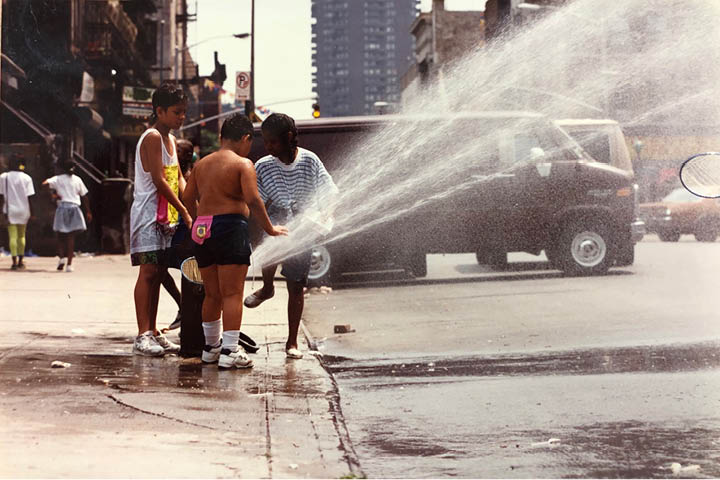
In celebration of El Museo del Barrio’s 50th anniversary, we have partnered with Nuevayorkinos, a digital visual archive dedicated to New York City’s Latinx population. The collaboration aims to highlight the long-standing presence and cultural contributions of Latinx communities in our home of El Barrio (East Harlem). In the summer of 2019, we co-hosted a number of pop-up installations at El Museo and issued an open call, asking visitors to submit images and videos of Latinx life in El Barrio from 1969 to 2005.
We are delighted to present “#MIBARRIO: Memories of Home,” a family album that celebrates our personal and shared histories in this neighborhood. This installation reminds us of the importance of heritage and the many ways that Latinx people have enriched the cultural fabric of New York City. In the midst of our barrios and communities facing socio-economic changes and displacement, this collaboration is an important reminder of our roles as advocates and guardians of our culture. We exist and our histories matter.
Pa’lante!
—-
Para celebrar el 50 Aniversario del Museo del Barrio, nos hemos asociado con Nuevayorkinos, un archivo visual digital dedicado a la población Latinx de la ciudad de Nueva York. La colaboración tiene como objetivo destacar la presencia y las contribuciones culturales de las comunidades Latinx desde hace numerosas décadas en nuestro hogar El Barrio (East Harlem). En el verano 2019, organizamos varias instalaciones en El Museo y lanzamos una convocatoria abierta, pidiendo a los visitantes que enviaran fotos y videos de la vida latina en El Barrio desde 1969 hasta 2005.
Estamos encantados de presentar “#MIBARRIO: Memories of Home,” un álbum familiar que celebra nuestras historias personales y compartidas en este vecindario. Esta instalación nos recuerda la importancia del patrimonio y las muchas formas en que las personas Latinx han enriquecido el tejido cultural de la ciudad de Nueva York. En medio de nuestros barrios y comunidades que enfrentan cambios y desplazamientos socioeconómicos, esta colaboración es un importante recordatorio del rol que tenemos como defensores y guardianes de nuestra cultura. Existimos y nuestras historias importan.
Pa’lante!
Picking Up the Pieces: An intimate view of life post-María
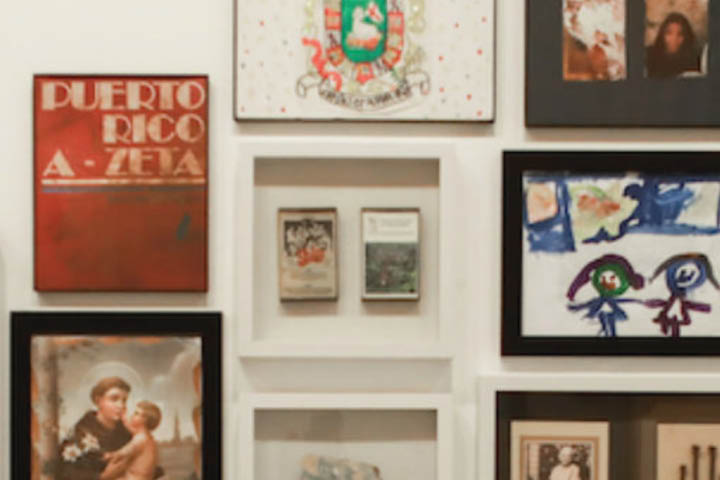
Picking Up the Pieces is an intimate look at life post-Hurricane María in Puerto Rico, and the unfortunate “new normal” of its people. Comprised of drawings, installations, and photographs that reflect unforgettable moments experienced by artist Adrián Viajero Román’s travels throughout the island, the installation creates portraits of individual lives profoundly touched by trauma and tragedy, and resilience.
Picking Up the Pieces es una mirada intima a la vida en Puerto Rico después del paso de Huracán Maria, y la desafortunada nueva vida de su gente. Compuesto de dibujos, instalaciones, y fotografías que reflejan los inolvidable momentos vividos por el artista Adrian Viajero Roman durante sus viajes a la isla, la instalación crea retratos de la vidas individuales profundamente afectada por trauma, tragedia, y resistencia.
Adrian Roman, also known as Viajero, was born in New York City of Puerto Rican descent. Throughout his travels to the Caribbean, Central America, Africa, and a number of cities across the United States, he has exposed himself to a variety of cultures that have influenced his work. Viajero is an artist resident of the NARS Foundation in Brooklyn New York, and works closely with the Caribbean Cultural Center African Disapora Institute in New York City. In 2012, he exhibited at Museo de Arte de Caguas, Puerto Rico as part of the group show AFROLATINOS, which was awarded Best Exhibit 2012 by International Association of Art Critics. Viajero was most recently nominated for the Joan Mitchell Foundation grant for sculpture. He has exhibited in solo and group shows in the United States and Puerto Rico.
Dreaming up North: Children on the Move Across the Americas
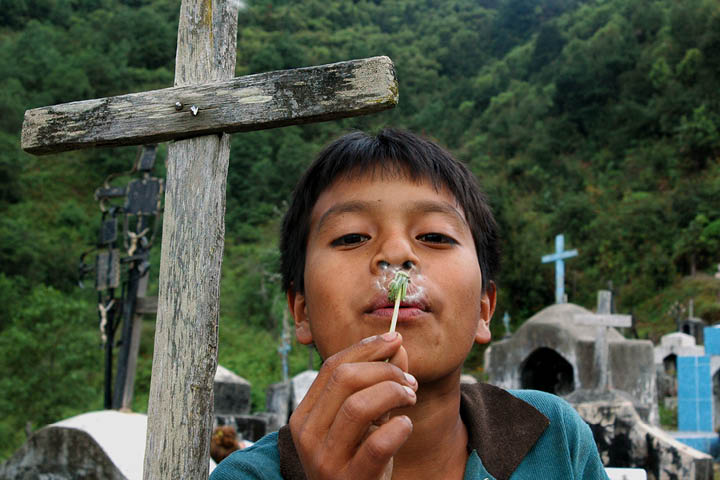
Dreaming up North: Children on the Move Across the Americas is a special exhibition in honor of Migration at El Museo del Barrio, revolving around testimonies (in graphic, oral and written form) of immigrant children moving across the Americas. Collected by a team of six anthropologists and three photographers, each working separately, the exhibition depicts migrant children from Mexico, El Salvador, Guatemala, Honduras, Ecuador, and Nicaragua. Dreaming up North draws upon interviews and workshops developed in humanitarian shelters, detention centers and transit areas within children’s hometowns and their new homes in the United States. Themes covered include: Mexico’s internal child migration and repatriation, transnational child migration from as far as Ecuador, the daily lives of migrant children in the US, and children’s future migration plans.
Dreaming up North aims to highlight the migrant children experience, in order to foster opportunities to understand this transnational phenomenon through their own voices and memories. By doing this we hope to contribute to a more complex and nuanced view of child migration. Such a view recognizes the tremendous suffering, stress, and danger that migrant children experience, but also illustrates that migrant children are not mere victims, being moved around by criminals or feckless parents. Instead, it argues that their mobility is also a result of the decisions and actions children take in order to shape their own futures in the face of failed national policies, insufficient international mechanisms of support and growing global inequality. When children migrate, they are claiming a human right, they are going home to their parents after many years apart, they are looking for an income that will provide their siblings with the opportunities they didn’t have, they are resisting gangs and drug cartels’ strategies of fear and domination. They are challenging our understanding of childhood, innocence, dependency, agency, citizenship, geography and time. They are asking us to reshape our conventional perceptions to be able to create a better, more understanding world, where borders aren’t walls that keep us apart, but spaces for new possibilities and learning.
EXHIBITION CREDITS
Dreaming up North: Children on the Move Across the Americas is presented by El Museo del Barrio, in collaboration with Colectiva Infancias, and a network of social anthropologists and photographers.
Coordination and assembly: Valentina Glockner | Script and museography: Soledad Álvarez and Valentina Glockner | Research: Ana Luz Minera, Cinthya Santos, Sandra Guillot, Sarah Gallo, Soledad Álvarez Velasco, Tamara Segura, Valentina Glockner | Photographic documentation: Cinthya Santos, Katie Orlinsky, Luis Enrique Aguilar, Valentina Glockner | Map design: Elvira Morán, with information from Soledad Álvarez, Tamara Segura, Valentina Glockner | Comics: Javier Beverido
In honor and thanks to the knowledge and trust of: Migrant children and adolescents working in agricultural fields in Chihuahua, Morelos and Michoacán, held at the Tapachula detention center in Chiapas, in transit at the shelters of Ixtepec, Oaxaca and Tenosique, Tabasco, and returned to the home communities of their families in Puebla, Mexico.
The exhibition is based on the experience of children and adolescents from Guatemala, Mexico, El Salvador, Honduras, Nicaragua, Ecuador and the United States. The testimonies exposed are transcriptions of the narratives obtained during the research work and photographic documentation.
videoarte: Elena Wen
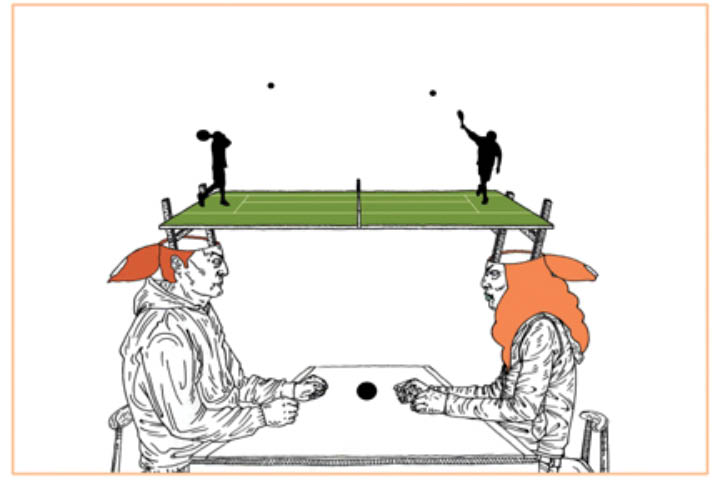
This mini solo exhibition features a series of animated film works that the artist created between 2005 and 2013. Urban scenes, colorful landscapes, gossipy or nonsensical conversations, science fiction-inspired scenes, and statistics all make an appearance among Elena’s charming animations. No single film is longer than three minutes, packing a great deal of playful significance into a mini epic.
Elena Wen was born in Taiwan, and moved to Costa Rica with her family when she was 3 years old. Wen studied Illustration at the School of Visual Arts in New York City and became an illustrator of limited edition art books that are now in the library collections of various institutions such as San Francisco MOMA, Getty Research Institute, Stanford and other university archives. Continuing her education in digital media at Parsons School of Design offered, the artist’s drawings became animation installations. She has exhibited at the A.I.R. Gallery, Flux Factory, and Secret Project Robot in NYC; at Lumen Eclipse in Harvard Square, Boston; and on the Great Wall of Oakland in California. She also in the Costa Rica Biennial in 2009, where her work was selected for the Central America Biennial exhibition (Bienal del Istmo Centroamericano) also in 2009. Her work was included in the 2011 bienal at El Museo del Barrio, The Street Files.
videoarte | Rotative Repository of Latin American Video Art: Mono Canal
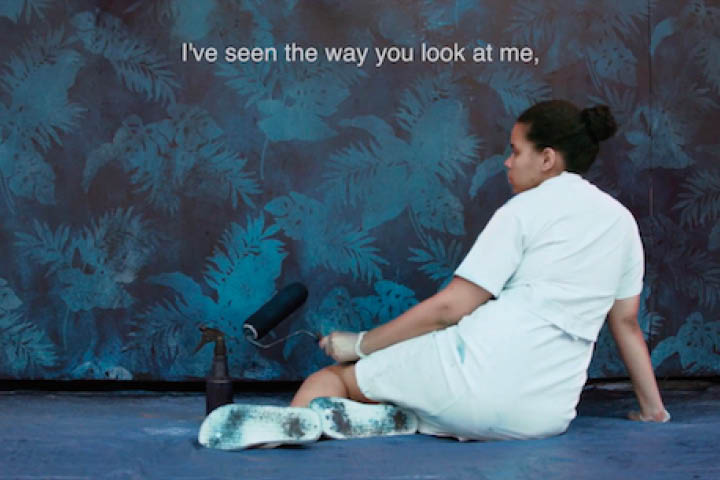
This exhibition explores the work of Latin American video artists and their different approaches to the single-channel format. The work on display ranges from pieces inspired by documentary or visual anthropology to others that eschew narrative structure for an approach more akin to visual poetry or performance. Curated by Hernan Rivera Luque.
The exhibited artists represent the strongest trends in the Latin American video art tradition. Their work fully embrace contemporary production techniques and conceptual approaches. Together they exemplify the multicultural discourse and critical thinking that have always been present in the complex identity of the Latin American countries, with incisive commentary on the historic migrations and political changes of the region as well as on topics such as gender, identity, politics and power.
In an attempt to convey the vitality of contemporary Latin American video art, this exhibition presents the work of established artists alongside the most exciting work from the new generation of video artists.
Participating artists: Maricruz Alarcón, Francisca Benitez, Alberto Borea, Nat Castañeda, Javier Castro, Lionel Cruet, Marcos Chaves, Gianfranco Foschino, Ignacio Gatica, Eduardo Gil, Alfredo Jaar, Joiri Minaya, Iván Navarro, Crack Rodriguez and Margarita Sanchez
+++
Repositorio rotativo de video arte latinoamericano mono canal – Edición El Museo del Barrio
Esta exposición explora el trabajo de video artistas latinoamericanos y sus diferentes de aproximación al formato mono canal. El trabajo en exhibición abarca desde piezas inspiradas por lo documental o la antropología visual hasta otras que evitan la estructura narrativa por un enfoque más afín a la poesía visual o el performance.
Los artistas expuestos representan las tendencias más fuertes de la tradición latinoamericana de video arte. Sus obras abarcan plenamente las técnicas de producción y conceptualización contemporáneas. Juntos ejemplifican el discurso multicultural y el pensamiento crítico que siempre han estado presentes en la compleja identidad de los países latinoamericanos, con comentarios sobre las migraciones históricas y los cambios políticos de la región, así como sobre temas de género, identidad, política y poder.
En un intento por transmitir la vitalidad del videoarte latinoamericano contemporáneo, esta exposición presenta la obra de artistas establecidos junto a la obra de nuevas generaciones de video artistas.
Artistas participantes: Maricruz Alarcón, Francisca Benítez, Alberto Borea, Nat Castañeda, Javier Castro, Marcos Chaves, Gianfranco Foschino, Ignacio Gatica, Eduardo Gil, Alfredo Jaar, Joiri Minaya, Iván Navarro, Crack Rodríguez y Margarita Sánchez.
+++
unoxuno is a series of solo projects for contemporary art at El Museo del Barrio. They focus on a single work or installation by a single artist or collaborative group.
The curator would like to thank New Latin Wave Festival for their support on this project.